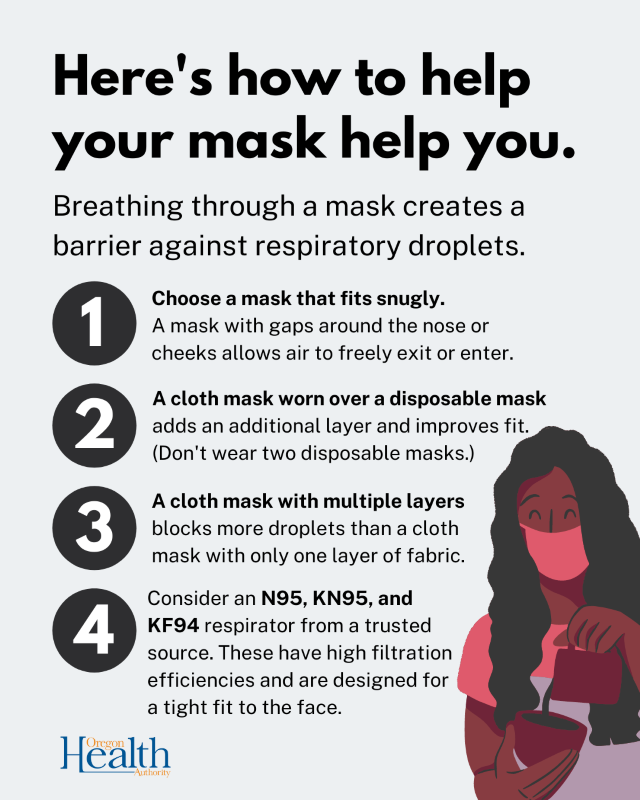-
Why Snug, Multi-Layered Masks Limit the Spread of COVID-19
1/10/2022Dear PPS Community,
While the best protection we have against COVID-19 continues to be vaccines plus booster shots, we know that when used correctly, face masks create an important barrier that reduces the spray of a person’s respiratory droplets, which can spread the virus that causes COVID-19. Because the Omicron variant spreads more easily than the Delta variant, wearing a well-fitting mask is more important than ever to slow the spread of COVID-19. To limit the spread of the Omicron variant, PPS continues to require individuals to wear masks at all times while on school campuses (indoor and outdoor) and on school buses, except when they eat lunch or have a drink.
Below are some tips from public health experts on proper use of masks:
- Masks should cover both the nose and mouth: Masks must be worn over the mouth and nose, which are both potential habitats for viruses.
- Cloth masks should have multiple layers of fabric: A cloth mask may be worn over a disposable mask. This adds a layer and improves the poor fit of disposable masks. Do not layer two disposable masks.
- A high-filtration efficiency mask with a tight fit to the face is another option. These include N95,
KN95, and KF94 respirators. - Do not wear masks with ventilation valves. These ventilation valves allow particles and droplets to escape into the air.
- A high-filtration efficiency mask with a tight fit to the face is another option. These include N95,
- Masks must fit snugly but comfortably against the sides of the face: Choose a mask that fits snugly against your face and is secure under your chin. A mask that has gaps around your nose or along your cheeks allows air to freely leave or enter. Masks with nose wires can improve the fit and ensure most air and breath is being filtered through the mask.
- Masks must allow for unrestricted breathing: A cloth mask with multiple layers of washable, breathable, tightly woven fabric blocks more droplets than a cloth mask with only one layer of fabric. A study by the University of Illinois found the first layer reduces the speed of the droplets that escape, thereby allowing the second layer to trap and block most of the remaining droplets, as much as 94 percent total. Some masks have space for an additional layer of fabric to be inserted.
If you are interested in learning more about how to select, properly wear, clean and store your masks, here are links to a few trusted resources:
- CDC: Your Guide to Masks: How to select, properly wear, clean, and store masks
- Healthy Children: Face Masks for Children During COVID-19
- Healthy Children: Mask Mythbusters: Common Questions about Kids & Face Masks
- VIDEO: How to Properly Wear a Mask
- JAMA Network: Why Wear a Mask?—Explaining Medical Masking to Children
In addition to personal protective equipment we ask every individual to wear, we’ve upgraded existing air filters in each of our schools' mechanical systems to MERV 13 standards. This higher level of filtration provides another layer of protection to fight against COVID transmission. And as part of the PPS multi-layer approach to protecting against COVID transmission, the District has distributed portable air purifiers into classrooms and many other areas in all District buildings. The portable air purifiers provide HEPA level air filtration, which is capable of removing 99.97% of particles of 0.3 microns. This is the standard filtration used to capture virus aerosols.
We continue to urge all members of our community who are eligible to please get vaccinated and boosted against the virus. We encourage you to talk to your children about proper and effective mask wearing on school campuses. Thank you for your patience and understanding and for doing your part to keep our community safe.
Portland Public Schools
By Month
- June 2025
- May 2025
- March 2025
- February 2025
- January 2025
- October 2024
- September 2024
- June 2024
- May 2024
- April 2024
- March 2024
- February 2024
- January 2024
- December 2023
- November 2023
- October 2023
- September 2023
- August 2023
- June 2023
- May 2023
- January 2023
- December 2022
- November 2022
- October 2022
- September 2022
- August 2022
- July 2022
- June 2022
- May 2022
- April 2022
- March 2022
- February 2022
- January 2022
- December 2021
- November 2021
- October 2021
- September 2021
- August 2021
- July 2021
- June 2021
- May 2021
- April 2021
- March 2021
- February 2021
- January 2021
- December 2020
- October 2020
- September 2020
- August 2020
- July 2020
- June 2020
- May 2020
- April 2020
- March 2020
- February 2020
- January 2020
- December 2019
- November 2019
- October 2019
- September 2019
- August 2019
- June 2019
- May 2019
- April 2019
- March 2019
- February 2019
- January 2019
- December 2018
- November 2018
- October 2018
- September 2018
- August 2018
- July 2018
- June 2018
- May 2018
- April 2018
- March 2018
- February 2018
- January 2018
- December 2017
- November 2017
- October 2017
- September 2017
- August 2017
- July 2017
- June 2017
- May 2017
- April 2017
- March 2017
- February 2017
- January 2017
- December 2016
- November 2016
- October 2016
- September 2016
- August 2016
- July 2016
- June 2016
- May 2016
- April 2016
- March 2016
- February 2016
- January 2016
- December 2015
- June 2015



